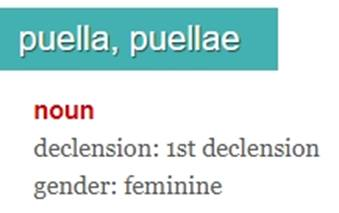Second important point: all nouns in a Latin dictionary and in other resources e.g. school textbooks are listed with the nominative and genitive singular. Look again at the tables in the previous post; the genitive is listed immediately below the nominative, that shows the stem changes and you can see the “domino effect” from there. There are two reasons for that:
[i] The genitive singular is the case ending conventionally
used to indicate what, if any, stem change there is in a 3rd declension noun.
It’s really important that you get a grip on that:
- rēx, rēgis [3/m] rēgis is the genitive singular and it is used to show you the stem change before the ending is added.
Here are a few more examples. The ending doesn’t change, but
the stem does.
- mīles, mīlit¦is [3/m]: soldier; the genitive singular indicates the stem change to milit-
- pēs, ped¦is [3/m]: foot; the genitive singular indicates the stem change to ped-
And so on:
- venter, ventris [3/m]: stomach; stem change to ventr-
- frōns, frontis [3/f]: forehead; stem change to front-
- lēx, lēgis [3/f]: law; stem change to lēg-
- nox, noctis [3/f]: night; stem change to noct-
- caput, capitis [3/n]: head; stem change to capit-
- corpus, corporis [3/n]: body; stem change to corpor-
- ōs, ōris [3/n]: mouth; stem change to ōr-
Some 3rd declension nouns don’t change the stem:
- aur¦is, aur¦is [3/f]: ear, but it will still be listed in that way to show that the stem doesn’t change
Similarly:
- class¦is, class¦is [3/f]: fleet (of ships); the stem ending doesn’t change
- fēl¦ēs, fēl¦is [3/f]: cat; the stem ending doesn’t change
When you open up the door of 3rd declension nouns – and
there are thousands of common ones that are in the literature – learning the
noun along with its genitive is as integral as learning le or la in
French or der, die, das in German.
[ii] The second reason why this genitive case form is listed
in the vocabulary is to differentiate between different declensions.
[a] hortus (2nd declension) [b] corpus (3rd
declension)
[a] puer (2nd declension) [b] māter (3rd
declension)
How do you know to which declension these nouns belong?
The answer is that you don’t. They look identical to one
another. Therefore, the dictionaries will list all nouns with their
genitive singular to show the declension they belong to because the
genitive singular is different for all the declensions.
puella, -ae [1]
hortus, -ī [2]
templum, -ī [2]
corpus, corporis [3]
So, if the genitive singular is -ae, it’s first
declension, if it’s -ī, it’s 2nd declension, and if it’s -is it’s
third declension. That’s what you need to look out for because that will tell
you to which declension a noun belongs and, therefore, what endings need to be
added.
Look at the images posted from https://latin-dictionary.net/. You'll see
that it lists the nominative and genitive singular of the nouns; that indicates
to what declension the noun belongs. Similarly, any stem change in 3rd
declension nouns is indicated.
Here are some nouns listed as they would appear in a
dictionary. To what declension do each of them belong (1st / 2nd/ 3rd)?
All you have to do is look at the genitive ending and you
have the answer. Note the ones in bold; without the genitive case ending
listed, you would not be able to tell to which declension they belong, but with
the genitive case ending included, you can immediately:
via, -ae: road
taurus, -ī: bull
pectus, pectoris: breast
culīna, -ae: kitchen
magister, magistrī: teacher
mare, maris: sea
schola, -ae: school
fluvius, -iī: rīver
vēritās, vēritātis: truth
magistra, -ae
gladius, -iī: sword
dux, dūcis: general
poēta, -ae
puer, -ī: boy
frāter, frātris: brother
opus, operis: work
nōmen, nōminis: name
flūmen, flūminis: river
sīdus, sīderis: star
cūstōs, cūstōdis: guard





No comments:
Post a Comment